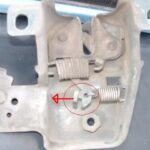Slight vacuum when removing the oil filler cap on your car engine is usually a sign of a properly functioning Positive Crankcase Ventilation (PCV) system. This system is crucial for engine health and performance. Let’s explore why.
Understanding Crankcase Vacuum and the PCV System
Combustion engines inherently produce blow-by gases – combustion byproducts that escape past the piston rings and into the crankcase. These gases contain unburnt fuel, water vapor, and acidic compounds that can contaminate engine oil and cause sludge buildup.
The PCV system addresses this issue by using engine vacuum to draw these harmful gases out of the crankcase. They are then routed back into the intake manifold to be re-burned, reducing emissions and protecting the engine. A slight vacuum at the oil filler cap indicates this system is working as intended, pulling air and blow-by gases through the crankcase.
What Excessive Vacuum or Pressure Indicates
While a small amount of vacuum is normal, excessive vacuum can signify a problem. This might indicate a clogged PCV valve or restricted hoses within the system. A clogged PCV valve can lead to increased crankcase pressure, potentially damaging seals and gaskets.
On the other hand, pressure instead of vacuum at the oil filler cap is a more serious issue. This usually points to excessive blow-by caused by worn piston rings or cylinder walls. This condition often leads to increased oil consumption, reduced engine performance, and potentially catastrophic engine damage.
Testing for Proper Crankcase Ventilation
A simple test can help determine if your PCV system is functioning correctly:
- With the engine running at idle, carefully remove the oil filler cap.
- Place a thin piece of paper (like a playing card) over the opening.
- If the paper is held in place by a light suction, the PCV system is likely working correctly.
- If the paper is blown off or flutters excessively, there might be excessive blow-by or a PCV system issue.
- Observe engine idle when removing the cap. A slight stumble indicates a proper air/fuel mixture. A speed increase suggests a rich mixture.
Maintaining Your PCV System
Regular maintenance is essential to ensure proper PCV system function:
- PCV Valve Replacement: Replace the PCV valve according to your vehicle’s maintenance schedule. A faulty valve can disrupt the entire system.
- Hose Inspection: Regularly inspect PCV hoses for cracks, clogs, or disconnections. Replace any damaged or deteriorated hoses.
Conclusion
Observing vacuum when removing the oil cap is generally a positive sign, indicating a functioning PCV system. However, excessive vacuum or pressure warrants further investigation. Maintaining your PCV system is crucial for engine longevity and optimal performance. If you have any concerns, consult a qualified mechanic for a thorough inspection and diagnosis.

